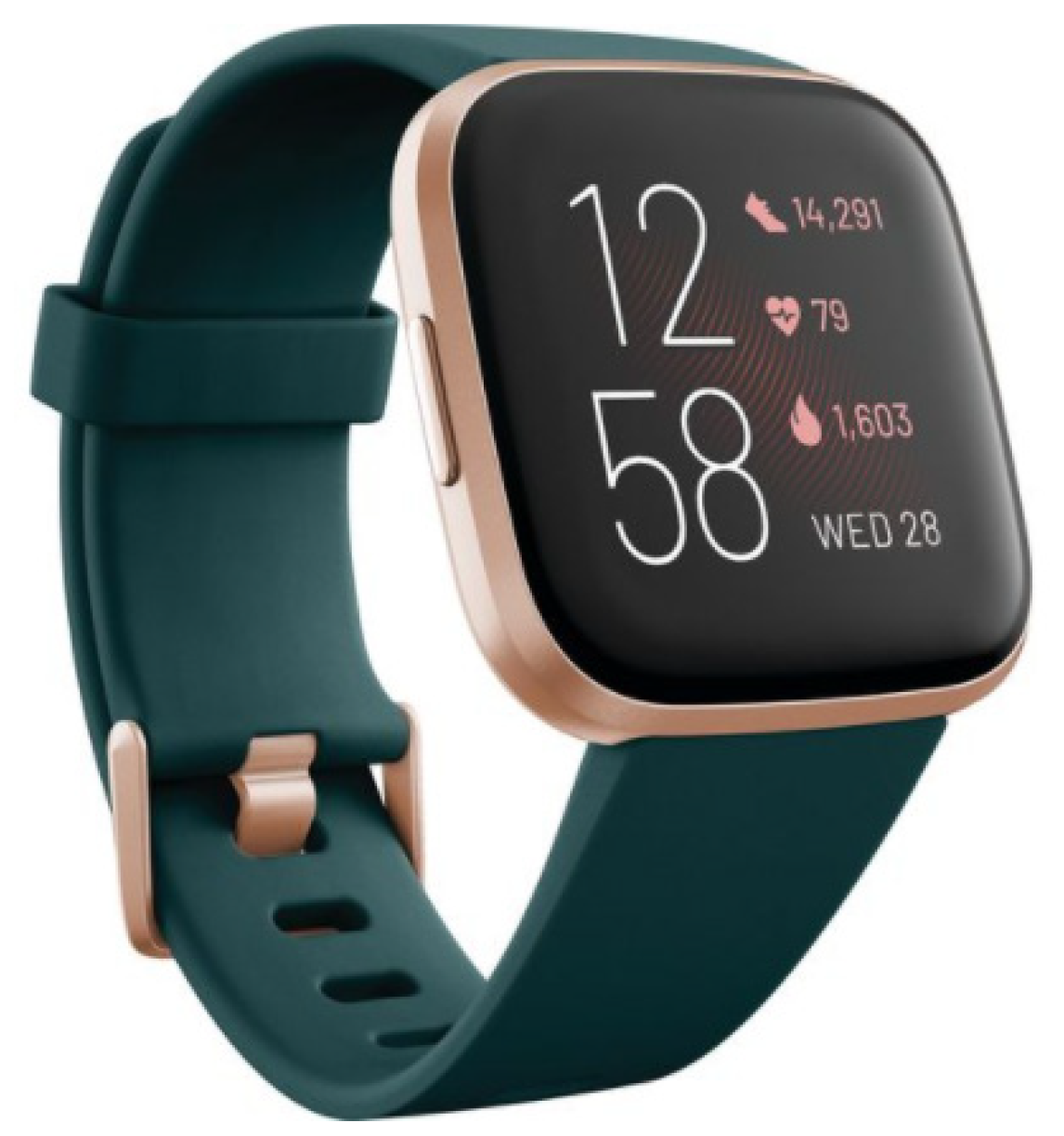Predictive Glucose Monitoring for People with Diabetes Using Wearable Sensors †
Abstract
:1. Introduction
2. Materials and Methods
Classification Algorithms
3. Results
4. Conclusions and Future Work
Author Contributions
Funding
Institutional Review Board Statement
Informed Consent Statement
Data Availability Statement
Acknowledgments
Conflicts of Interest
References
- Overview Type 1 Diabetes in Adults: Diagnosis and Management Guidance NICE. Available online: https://www.nice.org.uk/guidance/ng17 (accessed on 25 August 2021).
- Diabetes: The Basics. Available online: https://www.diabetes.org.uk/diabetes-the-basics (accessed on 25 August 2021).
- Non Communicable Diseases. Available online: https://www.who.int/news-room/fact-sheets/detail/noncommunicable-diseases (accessed on 25 August 2021).
- Myers, J. Exercise and Cardiovascular Health. Circulation 2003, 107, e2–e5. [Google Scholar] [CrossRef] [PubMed] [Green Version]
- Yardley, J.E.; Kenny, G.P.; Perkins, B.A.; Riddell, M.C.; Balaa, N.; Malcolm, J.; Boulay, P.; Khandwala, F.; Sigal, R.J. Resistance versus Aerobic Exercise: Acute Effects on Glycemia in Type 1 Diabetes. Diabetes Care 2013, 36, 537–542. [Google Scholar] [CrossRef] [PubMed] [Green Version]
- Woldaregay, A.Z.; Årsand, E.; Walderhaug, S.; Albers, D.; Mamykina, L.; Botsis, T.; Hartvigsen, G. Data-Driven Modeling and Prediction of Blood Glucose Dynamics: Machine Learning Applications in Type 1 Diabetes. Artif. Intell. Med. 2019, 98, 109–134. [Google Scholar] [CrossRef] [PubMed]
- Skovlund, S.E.; Peyrot, M. The Diabetes Attitudes, Wishes, and Needs (DAWN) Program: A New Approach to Improving Outcomes of Diabetes Care. Diabetes Spectr. 2005, 18, 136–142. [Google Scholar] [CrossRef] [Green Version]
- Leelarathna, L.; Wilmot, E.G. Flash Forward: A Review of Flash Glucose Monitoring. Diabetes Med. 2018, 35, 472–482. [Google Scholar] [CrossRef] [PubMed] [Green Version]
- Nsugbe, E.; Samuel, O.W.; Asogbon, M.G.; Li, G. Phantom Motion Intent Decoding for Transhumeral Prosthesis Control with Fused Neuromuscular and Brain Wave Signals. IET Cyber-Syst. Robot. 2021, 3, 77–88. [Google Scholar] [CrossRef]
- Nsugbe, E.; Obajemu, O.; Samuel, O.W.; Sanusi, I. Enhancing Care Strategies for Preterm Pregnancies by Using a Prediction Machine to Aid Clinical Care Decisions. Mach. Learn. Appl. 2021, 6, 100110. [Google Scholar] [CrossRef]
- Mancini, G.; Berioli, M.; Santi, E.; Rogari, F.; Toni, G.; Tascini, G.; Crispoldi, R.; Ceccarini, G.; Esposito, S. Flash Glucose Monitoring: A Review of the Literature with a Special Focus on Type 1 Diabetes. Nutrients 2018, 10, 992. [Google Scholar] [CrossRef] [PubMed] [Green Version]
- Moser, O.; Yardley, J.; Bracken, R. Interstitial Glucose and Physical Exercise in Type 1 Diabetes: Integrative Physiology, Technology, and the Gap In-Between. Nutrients 2018, 10, 93. [Google Scholar] [CrossRef] [PubMed] [Green Version]
- Kavakiotis, I.; Tsave, O.; Salifoglou, A.; Maglaveras, N.; Vlahavas, I.; Chouvarda, I. Machine Learning and Data Mining Methods in Diabetes Research. Comput. Struct. Biotechnol. J. 2017, 15, 104–116. [Google Scholar] [CrossRef] [PubMed]
- Sonar, P.; JayaMalini, K. Diabetes Prediction Using Different Machine Learning Approaches. In Proceedings of the 2019 3rd International Conference on Computing Methodologies and Communication (ICCMC), Erode, India, 27–29 March 2019; pp. 367–371. [Google Scholar]
- Fitbit Versa 2 Health & Fitness Smartwatch with Voice Control, Sleep Score & Music, Bordeaux, One Size, Exclusive to Amazon: Amazon.Co.Uk: Electronics & Photo. Available online: https://www.amazon.co.uk/Fitbit-Fitness-Smartwatch-Control-Bordeaux/dp/B07TWFWJDZ/ref=asc_df_B07TWFWJDZ/?tag=googshopuk-21&linkCode=df0&hvadid=381576046937&hvpos=&hvnetw=g&hvrand=1784791009843063600&hvpone=&hvptwo=&hvqmt=&hvdev=c&hvdvcmdl=&hvlocint=&hvlocphy=9045605&hvtargid=pla-817150174249&psc=1&th=1&psc=1&tag=&ref=&adgrpid=79549112322&hvpone=&hvptwo=&hvadid=381576046937&hvpos=&hvnetw=g&hvrand=1784791009843063600&hvqmt=&hvdev=c&hvdvcmdl=&hvlocint=&hvlocphy=9045605&hvtargid=pla-817150174249 (accessed on 25 August 2021).
- 233812-FITBIT Versa 2 with Amazon Alexa-Emerald & Copper Rose-Currys Business. Available online: https://business.currys.co.uk/catalogue/cameras-smart-tech/smart-tech/smart-watches-fitness/fitbit-versa-2-with-amazon-alexa-emerald-copper-rose/N555832W?cidp=Froogle&gclid=CjwKCAjwjJmIBhA4EiwAQdCbxpT0sUi09uhsVuglC3AaA6z7R6ivjTY2CwDagv-CcFVow3l3UfWjxRoCgqoQAvD_BwE&gclsrc=aw.ds (accessed on 25 August 2021).
- Nsugbe, E.; Phillips, C.; Fraser, M.; McIntosh, J. Gesture Recognition for Transhumeral Prosthesis Control Using EMG and NIR. IET Cyber-Syst. Robot. 2020, 2, 122–131. [Google Scholar] [CrossRef]
- Nsugbe, E.; Samuel, O.W.; Asogbon, M.G.; Li, G. Contrast of Multi-Resolution Analysis Approach to Transhumeral Phantom Motion Decoding. CAAI Trans. Intell. Technol. 2021, 6, 360–375. [Google Scholar] [CrossRef]
- Brownlee, J. SMOTE for Imbalanced Classification with Python; Machine Learning Mastery: San Juan, PR, USA, 2020. [Google Scholar]
- Nsugbe, E.; Ruiz-Carcel, C.; Starr, A.; Jennions, I. Estimation of Fine and Oversize Particle Ratio in a Heterogeneous Compound with Acoustic Emissions. Sensors 2018, 18, 851. [Google Scholar] [CrossRef] [PubMed] [Green Version]
- Nsugbe, E.; Samuel, O.W.; Asogbon, M.G.; Li, G. A Self-Learning and Adaptive Control Scheme for Phantom Prosthesis Control Using Combined Neuromuscular and Brain-Wave Bio-Signals. Eng. Proc. 2020, 2, 59. [Google Scholar] [CrossRef]


| Feature * | Range |
|---|---|
| Calories(kcal) | 1500–2000 |
| Number of steps | 1000–20,000 |
| Distance(miles) | 0.70–13.50 |
| Minutes sedentary | 300–1500 |
| Activity calories(kcal) | 200–1500 |
| Classifier | CA | PR | RC |
|---|---|---|---|
| QDA | 72.3 ± 1.6 | 68.9 ± 3.8 | 74.4 ± 1.8 |
| SVM | 72.6 ± 2.4 | 69.0 ± 3.5 | 74.2 ± 2.3 |
Publisher’s Note: MDPI stays neutral with regard to jurisdictional claims in published maps and institutional affiliations. |
© 2021 by the authors. Licensee MDPI, Basel, Switzerland. This article is an open access article distributed under the terms and conditions of the Creative Commons Attribution (CC BY) license (https://creativecommons.org/licenses/by/4.0/).
Share and Cite
Adams, D.; Nsugbe, E. Predictive Glucose Monitoring for People with Diabetes Using Wearable Sensors. Eng. Proc. 2021, 10, 20. https://doi.org/10.3390/ecsa-8-11317
Adams D, Nsugbe E. Predictive Glucose Monitoring for People with Diabetes Using Wearable Sensors. Engineering Proceedings. 2021; 10(1):20. https://doi.org/10.3390/ecsa-8-11317
Chicago/Turabian StyleAdams, Dawn, and Ejay Nsugbe. 2021. "Predictive Glucose Monitoring for People with Diabetes Using Wearable Sensors" Engineering Proceedings 10, no. 1: 20. https://doi.org/10.3390/ecsa-8-11317







